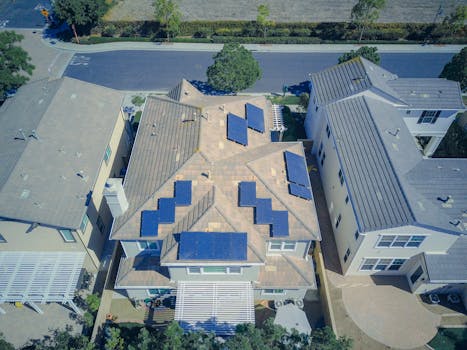“Empower Your Energy: Master the Basics of Solar Inverters.”
Solar inverters are essential components of solar energy systems, converting the direct current (DC) generated by solar panels into alternating current (AC) that can be used by household appliances and fed into the electrical grid. Understanding the basics of solar inverters involves exploring their types, functions, and importance in maximizing energy efficiency and system performance. This knowledge is crucial for homeowners and businesses looking to invest in solar technology, as it helps in selecting the right inverter to meet specific energy needs and ensuring optimal operation of solar power systems.
Types of Solar Inverters
Solar inverters play a crucial role in the functionality of solar energy systems, converting the direct current (DC) generated by solar panels into alternating current (AC), which is the form of electricity used in homes and businesses. Understanding the different types of solar inverters is essential for anyone considering a solar energy system, as each type has its unique features, advantages, and applications.
The most common type of solar inverter is the string inverter. This system connects multiple solar panels in a series, or “string,” allowing the inverter to convert the combined output of the panels into AC electricity. String inverters are popular due to their simplicity and cost-effectiveness, making them an ideal choice for residential installations where panels are installed on a single roof plane. However, one limitation of string inverters is that the performance of the entire string can be affected by the shading or malfunction of a single panel. This means that if one panel underperforms, it can reduce the overall energy output of the entire string.
In contrast, microinverters offer a more advanced solution by attaching a small inverter to each individual solar panel. This configuration allows each panel to operate independently, maximizing energy production even if some panels are shaded or dirty. As a result, microinverters can significantly enhance the overall efficiency of a solar energy system, particularly in installations where panels may face varying conditions. Although microinverters tend to be more expensive than string inverters, their ability to optimize performance can lead to greater energy yields over time, making them a worthwhile investment for many homeowners.
Another type of solar inverter is the power optimizer, which combines features of both string inverters and microinverters. Power optimizers are installed on each solar panel, but instead of converting DC to AC at the panel level, they condition the DC output before sending it to a central string inverter. This setup allows for improved energy harvesting from each panel while still benefiting from the cost-effectiveness of a string inverter. Power optimizers can be particularly advantageous in installations with shading issues or varying panel orientations, as they help mitigate the impact of underperforming panels on the overall system.
For larger commercial or utility-scale solar installations, central inverters are often employed. These inverters are designed to handle high power outputs and can connect to multiple strings of solar panels. Central inverters are typically more efficient and cost-effective for large-scale projects, as they simplify the system design and reduce the number of inverters needed. However, similar to string inverters, the performance of a central inverter can be affected by the underperformance of individual panels, making them less suitable for installations with significant shading or orientation challenges.
As the solar industry continues to evolve, new technologies and innovations are emerging, including hybrid inverters that can manage both solar energy and battery storage systems. These inverters allow homeowners to store excess energy generated during the day for use during the night or during power outages, providing greater energy independence and resilience.
In conclusion, understanding the various types of solar inverters is essential for making informed decisions about solar energy systems. Each type offers distinct advantages and is suited to different applications, whether for residential, commercial, or utility-scale projects. By carefully considering the specific needs and conditions of a solar installation, individuals can select the most appropriate inverter technology to maximize their energy production and investment.
How Solar Inverters Work

Solar inverters play a crucial role in the functionality of solar energy systems, acting as the bridge between the solar panels and the electrical grid or home appliances. To understand how solar inverters work, it is essential to first grasp the fundamental process of solar energy conversion. Solar panels generate direct current (DC) electricity when sunlight strikes their photovoltaic cells. However, most homes and electrical grids operate on alternating current (AC) electricity. This is where solar inverters come into play, converting the DC electricity produced by the solar panels into AC electricity that can be used to power household appliances or fed back into the grid.
The operation of a solar inverter begins with its ability to monitor the output of the solar panels. It continuously assesses the voltage and current produced by the panels to ensure optimal performance. This monitoring is vital because solar energy production can fluctuate due to changes in sunlight intensity, weather conditions, and the angle of the sun throughout the day. By adjusting the output accordingly, the inverter maximizes energy production and efficiency. This process is known as maximum power point tracking (MPPT), which allows the inverter to extract the maximum possible power from the solar panels at any given time.
Once the inverter has converted the DC electricity into AC electricity, it must synchronize this output with the grid or the home’s electrical system. This synchronization involves matching the voltage, frequency, and phase of the AC electricity produced by the inverter with that of the grid. This is a critical step because any discrepancies could lead to inefficiencies or even damage to the electrical system. Advanced inverters are equipped with sophisticated algorithms that ensure seamless integration with the grid, allowing for a stable and reliable power supply.
In addition to converting and synchronizing electricity, solar inverters also serve as a safety mechanism. They are designed to disconnect from the grid in the event of a power outage, preventing back-feeding of electricity, which could pose risks to utility workers repairing lines. This feature, known as anti-islanding, is essential for maintaining safety standards in solar energy systems. Furthermore, many modern inverters come with built-in monitoring capabilities, allowing users to track their energy production and consumption in real-time. This data can be invaluable for optimizing energy use and understanding the performance of the solar energy system.
Moreover, there are different types of solar inverters available on the market, each with its unique features and benefits. String inverters are the most common type, connecting multiple solar panels in series. However, in situations where shading or varying panel performance is a concern, microinverters or power optimizers may be more suitable. These devices are installed on each individual panel, allowing for independent operation and maximizing energy production even when some panels are less efficient due to shading or dirt.
In conclusion, solar inverters are integral to the functionality of solar energy systems, facilitating the conversion of DC electricity to AC electricity while ensuring safety and efficiency. By understanding how solar inverters work, homeowners and businesses can make informed decisions about their solar energy investments. As technology continues to advance, the role of solar inverters will only become more significant, paving the way for a more sustainable and energy-efficient future.
Benefits of Using Solar Inverters
Solar inverters play a crucial role in the efficiency and effectiveness of solar energy systems, serving as the bridge between the solar panels and the electrical grid or home appliances. Understanding the benefits of using solar inverters is essential for anyone considering the transition to solar energy. One of the primary advantages of solar inverters is their ability to convert direct current (DC) generated by solar panels into alternating current (AC), which is the form of electricity used by most household appliances and the electrical grid. This conversion is vital, as it allows homeowners to utilize the energy produced by their solar panels effectively.
Moreover, solar inverters enhance the overall efficiency of solar energy systems. By optimizing the energy output from solar panels, inverters ensure that the maximum amount of electricity is harnessed from sunlight. Advanced inverter technologies, such as maximum power point tracking (MPPT), continuously monitor the performance of solar panels and adjust the electrical load to capture the highest possible energy yield. This capability is particularly beneficial in varying weather conditions, where sunlight intensity can fluctuate. Consequently, homeowners can enjoy increased energy production, leading to greater savings on their electricity bills.
In addition to improving energy efficiency, solar inverters also contribute to the longevity and reliability of solar energy systems. They are equipped with safety features that protect both the solar panels and the electrical grid from potential damage caused by power surges or faults. For instance, inverters can automatically disconnect from the grid during outages, preventing back-feeding electricity that could endanger utility workers. This safety mechanism not only safeguards the equipment but also enhances the overall reliability of the solar energy system, providing peace of mind to users.
Furthermore, solar inverters often come with monitoring capabilities that allow homeowners to track their energy production and consumption in real-time. This feature is invaluable for those who wish to optimize their energy usage and identify any potential issues with their solar system. By having access to detailed performance data, users can make informed decisions about their energy consumption habits, leading to further savings and increased efficiency. Additionally, many modern inverters are equipped with smart technology that enables remote monitoring and control through mobile applications, making it easier than ever to manage solar energy systems.
Another significant benefit of solar inverters is their contribution to environmental sustainability. By facilitating the use of clean, renewable energy, inverters help reduce reliance on fossil fuels and lower greenhouse gas emissions. As more homeowners adopt solar energy systems, the cumulative effect of using solar inverters can lead to a substantial decrease in carbon footprints, promoting a healthier planet for future generations. This environmental impact is increasingly important in today’s world, where climate change and sustainability are at the forefront of global discussions.
In conclusion, the benefits of using solar inverters extend far beyond mere energy conversion. They enhance the efficiency and reliability of solar energy systems, provide valuable monitoring capabilities, and contribute to environmental sustainability. As the demand for renewable energy continues to grow, understanding the pivotal role of solar inverters becomes essential for anyone looking to harness the power of the sun effectively. By investing in quality solar inverters, homeowners can maximize their energy production, enjoy significant cost savings, and play a part in creating a more sustainable future.
Common Issues with Solar Inverters
Solar inverters play a crucial role in the functionality of solar energy systems, converting the direct current (DC) generated by solar panels into alternating current (AC) that can be used by household appliances and fed into the electrical grid. However, like any technology, solar inverters can encounter various issues that may affect their performance and efficiency. Understanding these common problems is essential for both current and prospective solar energy users, as it can help in troubleshooting and maintaining the system effectively.
One of the most prevalent issues with solar inverters is overheating. Inverters are designed to operate within a specific temperature range, and excessive heat can lead to reduced efficiency or even complete shutdown. This overheating can be caused by several factors, including poor ventilation, high ambient temperatures, or excessive dust accumulation on the inverter’s cooling fins. To mitigate this issue, it is advisable to install the inverter in a shaded, well-ventilated area and to perform regular maintenance checks to ensure that dust and debris do not obstruct airflow.
Another common problem is inverter failure, which can stem from various sources, including manufacturing defects, electrical surges, or prolonged exposure to harsh environmental conditions. When an inverter fails, it can result in a significant loss of energy production, as the solar panels will no longer be able to convert their output into usable electricity. Regular monitoring of the inverter’s performance can help detect early signs of failure, such as unusual error codes or a drop in energy output. In many cases, manufacturers provide warranties that cover repairs or replacements, making it essential for users to keep track of their inverter’s warranty status.
In addition to overheating and failure, communication issues can also arise between the solar inverter and the monitoring system. Many modern inverters come equipped with monitoring capabilities that allow users to track energy production and system performance remotely. However, connectivity problems can occur due to faulty wiring, poor internet connections, or software glitches. These issues can hinder the ability to monitor the system effectively, making it difficult to identify and address other potential problems. To resolve communication issues, users should ensure that all connections are secure and that the monitoring software is up to date.
Moreover, inverter performance can be affected by shading on the solar panels. When even a small portion of a panel is shaded, it can lead to a significant drop in energy production, as solar panels are interconnected in a series. This phenomenon, known as the “Christmas light effect,” can cause the entire string of panels to underperform. To combat this issue, users should regularly assess their solar array for any obstructions, such as overhanging branches or debris, and take proactive measures to maintain optimal sunlight exposure.
Lastly, inverter efficiency can degrade over time due to wear and tear. As with any electronic device, components within the inverter can deteriorate, leading to reduced performance. Regular maintenance and timely upgrades can help prolong the lifespan of the inverter and ensure that it operates at peak efficiency. Users should consult with qualified solar technicians to perform routine inspections and address any potential issues before they escalate.
In conclusion, while solar inverters are generally reliable, they are not immune to problems. By understanding the common issues associated with solar inverters, users can take proactive steps to maintain their systems, ensuring optimal performance and longevity. Regular monitoring, maintenance, and timely interventions are key to maximizing the benefits of solar energy.
Q&A
1. **What is a solar inverter?**
A solar inverter is a device that converts the direct current (DC) electricity generated by solar panels into alternating current (AC) electricity, which can be used by home appliances and fed into the electrical grid.
2. **What are the main types of solar inverters?**
The main types of solar inverters are string inverters, microinverters, and power optimizers. String inverters connect multiple solar panels in series, microinverters are installed on each panel individually, and power optimizers work with string inverters to maximize energy output from each panel.
3. **What is the role of a solar inverter in a solar power system?**
The solar inverter regulates the voltage and current from the solar panels, ensures the system operates efficiently, and provides monitoring capabilities to track energy production and system performance.
4. **How does a solar inverter affect energy efficiency?**
A solar inverter affects energy efficiency by optimizing the conversion of DC to AC power, managing the output based on energy demand, and minimizing losses due to shading or panel mismatch, ultimately maximizing the overall energy yield of the solar power system.
Conclusion
Understanding the basics of solar inverters is essential for optimizing solar energy systems. Solar inverters play a crucial role in converting the direct current (DC) generated by solar panels into alternating current (AC) suitable for household use and the electrical grid. Familiarity with different types of inverters, such as string inverters, microinverters, and power optimizers, allows users to select the most appropriate technology for their specific needs. Additionally, knowledge of inverter efficiency, monitoring capabilities, and grid compatibility can enhance system performance and reliability. Overall, a solid grasp of solar inverters contributes to maximizing energy production, ensuring system longevity, and achieving a successful transition to renewable energy sources.




